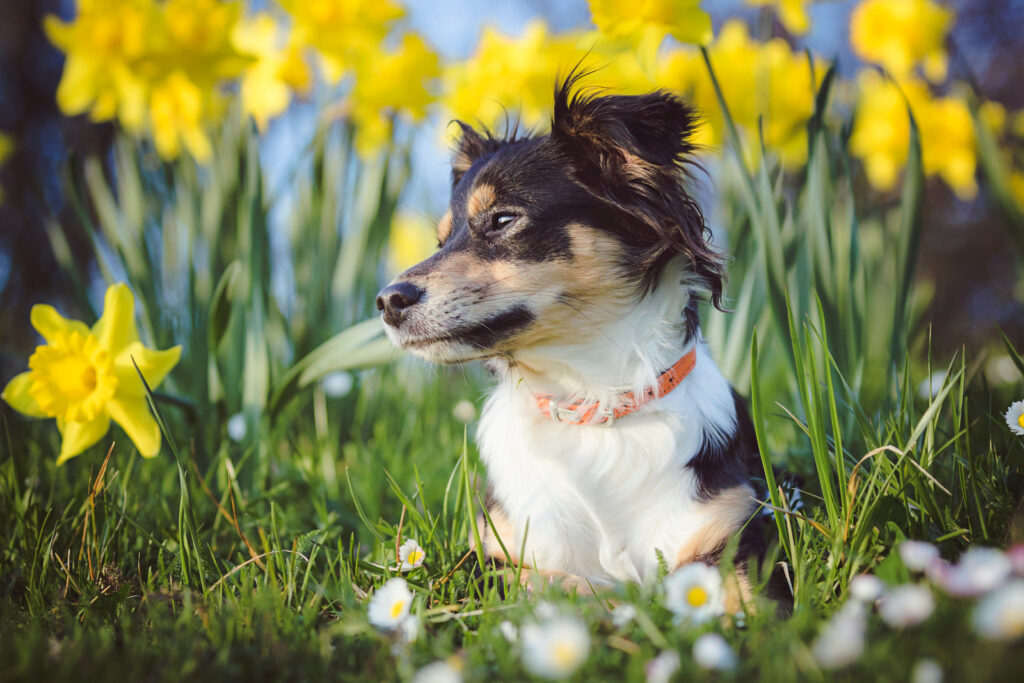…and other spring hazards
When spring is in the air, we can look forward to loads of seasonal snacks and colourful flowers over the Easter break! But while we love to share Easter time with our dogs and cats, we do have to be careful not to share our Easter treats with them too. In fact, some of our favourite treats in springtime can make our furry friends very ill. Here’s a quick run-through of some of the spring hazards to watch out for and what to do if your dog ate your Easter egg…
Easter eggs and other chocolates
First on the list of Easter dangers is chocolate. While this is a delicious food for us, it’s very dangerous to our canine and feline friends. Unfortunately, many dogs love the taste of chocolate and will snaffle an unguarded Easter egg if they get the chance! Cats are generally less keen on our Easter chocs as they don’t taste sweet foods the way we do, but you still have to be careful with some inquisitive moggies.
But why is this sweet treat so dangerous for our pets? Are dogs allergic to chocolate? In actual fact, rather than it being an allergy issue, the problem is that there’s a particular chemical in chocolate that’s poisonous to our furry friends. This is called ‘theobromine’, and it’s a stimulant a bit like caffeine. It’s not dangerous to us humans because we can break it down, but our pet pals don’t have this ability. This means the chemical builds up in their bodies and has dangerous effects on a whole lot of organs including the gut, kidney, heart and central nervous system.
Since theobromine affects all these different parts of the body, there are a range of dog chocolate poisoning symptoms that can crop up between 4 and 24 hours after they’ve eaten the toxin. A dog with chocolate poisoning may have:
- Vomiting and diarrhoea
- Restlessness and agitation
- Rapid breathing/panting and a racing heart
- Incoordination
- Tremors or seizures
How severe the symptoms will be depends on how much theobromine your pet eats relative to their body size. So, for a given Easter egg, a smaller dog would be worse affected than a larger dog. The amount of theobromine also varies depending on the type of chocolate – there’s more in dark than milk chocolate, so this is the riskiest type. White chocolate doesn’t contain enough theobromine to cause toxicity, but it’s still dangerous for dogs as the high fat level can cause pancreatitis, which is a very painful and serious condition.

What to do if your pet has eaten chocolate
So, what should you do if your dog ate your Easter egg or other chocolates? Basically, as soon as you discover what’s happened it’s best to call the vet straight off. They’ll ask you a few questions in order to work out whether your pet’s at risk and if you should bring them in for treatment. You might not know all the answers if your dog’s raided an unknown amount of chocolate, but just give any information you can.
The vet is likely to ask what type of chocolate your dog’s eaten, how much, and how long ago they ate it. They might also ask how much your dog weighs if they don’t already know. If they ask you to bring your pet in, they may request that you bring the chocolate wrapper if possible.
If you manage to bring a dog who ate chocolate to the vet practice only a short time after they’ve eaten it, your vet may give them a special drug to make them sick and get it out of their system. They might also give another treatment by mouth to stop any remaining chocolate being absorbed. This may be all the treatment your pooch needs – if this is the case, they might have got off lightly and you’ll just need to keep a close eye on them! If you only find out that your dog’s eaten chocolate once they’ve started showing symptoms, however, your pet will probably need to stay in the vet practice for emergency supportive care. Your vet will be able to advise you on how serious the situation is and what they can do to help your pet.
Preventing chocolate toxicity
To avoid the risks of chocolate poisoning, it’s important to keep your Easter chocolate hidden well away out of the reach of prying paws, preferably in a lockable cupboard. What’s more, never give your dog chocolate as a treat, even if it’s only a little bit. There are lots of fab Easter treats for dogs that don’t come with the risks – for example, carob treats contain a chocolate substitute which is perfectly safe for our canine pals! If you want your pet to get the full Easter egg experience, you can treat them to a carob Easter egg for dogs or a catnip flavoured Easter egg for cats!
Hot cross buns
Another seasonal Easter food that’s best kept out of paw’s reach is hot cross buns. These delicious toastable snacks contain raisins, sultanas and currants, all of which are highly poisonous to dogs and cats. These dried fruits are all made from grapes, which can cause potentially fatal kidney failure in our furry friends, though scientists still don’t fully understand the mechanism of the kidney damage.
Unfortunately, with grapes and their dried counterparts there’s not a clear link between the amount eaten and the severity of the effects. While some dogs may not have problems after eating a mouthful of raisins, even large dogs have become very ill after eating just one or two. This means that it’s safest to consider any amount of this fruit to be a risk for your furry friend. If your pet is begging for a bite while you’re enjoying your hot cross bun, don’t give into their pleading eyes but think about a pet safe treat instead.
What to do if your dog eats a hot cross bun?
It’s always best to call your vet as soon as possible. Again, if you’re able to pop your pet down to the vet practice nice and early, it may be possible to avoid any future problems by making them sick and getting the raisins out of their system.
If our pets manage to eat grapes or raisins without us finding out, they can develop signs of poisoning as early as 6 hours afterwards and kidney failure can develop after 1–3 days. Signs to watch out for include vomiting, diarrhoea, drooling, lack of appetite, weakness, lethargy, and abnormal drinking or urination. If your pet shows any worrying signs, take them to your vet and they can carry out tests to check the kidneys if they’ve got any concerns. While kidney failure is very serious, the earlier the problem is picked up the better the chance of making a good recovery.
Easter lilies
While they’re not on the list of springtime tasty treats, flowers are another popular gift at Easter time. Bouquets in the home often contain Easter lilies, but these beautiful flowers are highly poisonous to cats. In fact, any part of the plant including the petals, pollen, leaves and stems are a risk to our feline friends. Even if you think your cat is unlikely to try to eat the plant, that doesn’t mean they’re safe with lilies around – cats can easily brush past the flowers and get the pollen on their fur, and then lick this off when grooming.
This means that if you have a feline friend, it’s safest not to have any of these dangerous flowers in the house or garden at all. There are other types of lilies to beware of as well: all ‘true’ lilies including Asiatic, Rubrum, Day, Tiger, Japanese and Stargazer lilies are highly poisonous to our feline pals.
Like grapes, lilies affect the kidneys, and symptoms of lily poisoning include vomiting, inappetence, drooling, lethargy and depression. When kidney failure develops then you may see your cat urinating more than usual, though if the kidneys are under a lot of strain then your pet may stop urinating at all. Seizures can also develop in very severe poisoning.
If you find out that your cat has eaten any part of a lily plant, it’s vital that you take them to the vet as soon as possible. If your feline friend can get started on supportive treatment straight away, they’ll have a much better chance of making a good recovery.

Other spring bulbs
Unfortunately, lilies aren’t the only spring flowers that can be a hazard to our pets! Daffodils are another bulb to beware of. While these beautiful yellow trumpets bring us joy as they usher in the springtime, they contain toxins that are harmful to pets. These toxins typically cause vomiting and diarrhoea, but they can also affect the heart at higher doses and can sometimes cause collapse. Both cats and dogs can become ill after eating daffodil flowers or bulbs, or even after drinking water from a daffodil vase.
While daffodils and lilies are responsible for most severe cases of spring bulb poisoning, other flowers can also be dangerous including bluebells, spring crocuses, hyacinths, irises, snowdrops and tulips. These can all cause vomiting or diarrhoea if eaten. So do remember to be careful about flowers in vases or in your garden, and keep an eye on your pooch while they’re out on walks in case they get into mischief.
Now you know what to do if your dog ate your Easter egg and how to avoid other spring hazards!
Found these tips helpful? Join Vital Pet Club’s e-news to be the first to hear about exclusive pet freebies and pet care tips!


